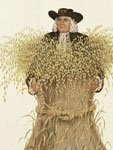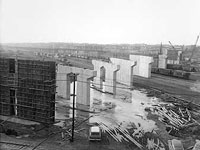Pemberton Township Historic Trust and North Pemberton Railroad Station Museum [NJ]
Cannot find a website with substantive information on the site.
Cannot find a website with substantive information on the site.
The train started running to Califon in 1875. Though the Central of New Jersey Railroad built both a wooden freight station and passenger station, the citizenry of Califon, proud of their town, replaced it at their own expense with the stone structure which today houses the Society and its museum.
Website provides very few specifics about the museum and the services the society offers.
Cannot find a website.
Appears to operate a farm museum, but very few specifics on website.
This general museum displays collections of antique fire apparatus, 1800s hand-drawn hose carts, an 1850s silver hose carriage, and firefighter uniforms and memorabilia.
The museum offers exhibits.

While many Quakers owned slaves prior to the American Revolution, the Quakers passed a rule in 1758 forbidding their members to buy or sell slaves. This lesson examines how the Quakers' religious views influenced their opposition to slavery during the Revolutionary period. We like that students are asked to analyze a series of primary sources to identify the reasoning behind the Quaker's anti-slavery stance.
The lesson plan suggests that teachers begin by delivering a lecture based on an online talk by historian Jean Soderlund. (Adobe Flash Player and Acrobat Reader are required to access the lecture). However, the historian’s lecture is brief, informative, and fairly engaging, so teachers may want to consider playing the lecture for students.
Next, students are asked to read a set of documents written by Quakers in the 18th century, and identify the various reasons Quakers were opposed to slavery. The documents are rich and informative. However, the language is challenging; and teachers may need to modify and shorten the documents, and create guiding questions to help students analyze them.
For an assessment, middle school students create protest pamphlets expressing the reasons behind Quaker opposition to slavery. High school students analyze the Declaration of Independence from the Quaker perspective. High school teachers may want to consider having students also analyze the original draft of the Declaration of Independence which had much stronger language opposing slavery. The original draft of the Declaration of Independence reflects more of Jefferson’s personal views, while the final version reflects more of the consensus view of congress.

Yes
Yes
The plan provides a brief historical overview and a historian's lecture.
Yes
Students must read primary sources and respond with a written assessment.
Yes
Students read several primary documents to determine the reasons behind Quaker opposition to slavery in the 18th century.
Yes
No
The language of the documents may have to be modified—especially for middle school students.
No
Teachers should consider providing students with a few focusing questions for each document.
Yes
There are different assessments for the high school and middle school level. However, no rubrics or specific assessment criteria are included.
Yes
Yes
A sleek lesson that could be done in one or two class periods.

This site uses about 45 sources to document the planning and construction of the New Jersey Turnpike, opened after two years of construction in 1952.
Building It contains a 1,000-word history of the turnpike's construction, as well as eight primary documents from the planning stages of the highway, including an early map of the proposed route. A dozen promotional documents (pamphlets, public announcements, bond solicitations) and newspaper coverage are also available as is a narrative account of tensions in Elizabeth, NJ, where more than 200 citizens were displaced to build the highway.
Driving It includes 10 accounts from many of the first to drive along the turnpike, advertisements from Howard Johnson's and other turnpike concessionaires, and an excerpt from a 1950s film on highway safety.
Telling It features 16 primary sources, 10 driver stories, and accounts from toll collectors, as well as the story of the first highway worker to lose his life on duty in 1967.
Three Detour sections allow visitors a little diversion with short activities: visitors can match up song lyrics that mention the turnpike with the artists who wrote them (Bruce Springsteen and Simon and Garfunkel are included).
For teachers, the site includes an annotated bibliography of works for various age groups.

More than 12,000 stereoscopic photographs depict life in small towns, villages, rural areas, and cities throughout New York, New Jersey, and Connecticut from 1850 to 1920 on this website. Materials include pictures of buildings, street scenes, natural landscapes, agriculture, industry, transportation, homes, businesses, local celebrations, natural disasters, and people.
Each grouping of photographs offers a short description of the contents as well as notes on the locations, medium, collection names, and digital identification information. The site also features an essay on the history of stereoscopic views and nine related website links. The site is searchable by keyword and can be browsed by subject and image name. These revealing illustrations are valuable for examining rural and urban development as well as everyday life.